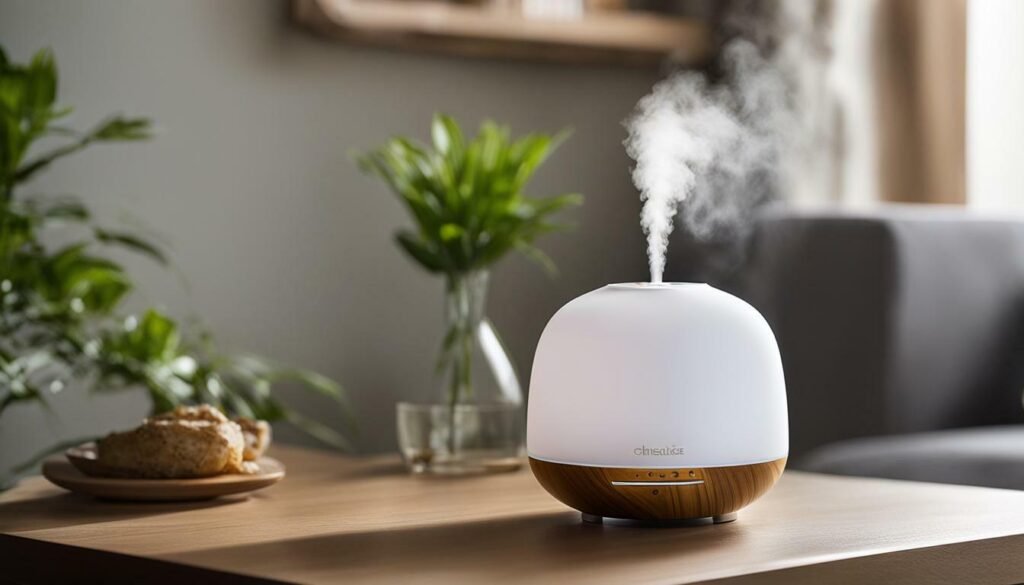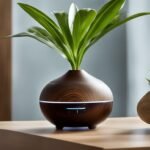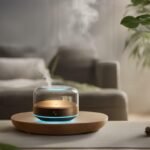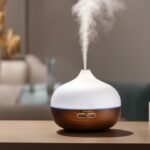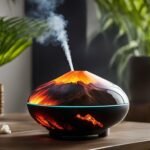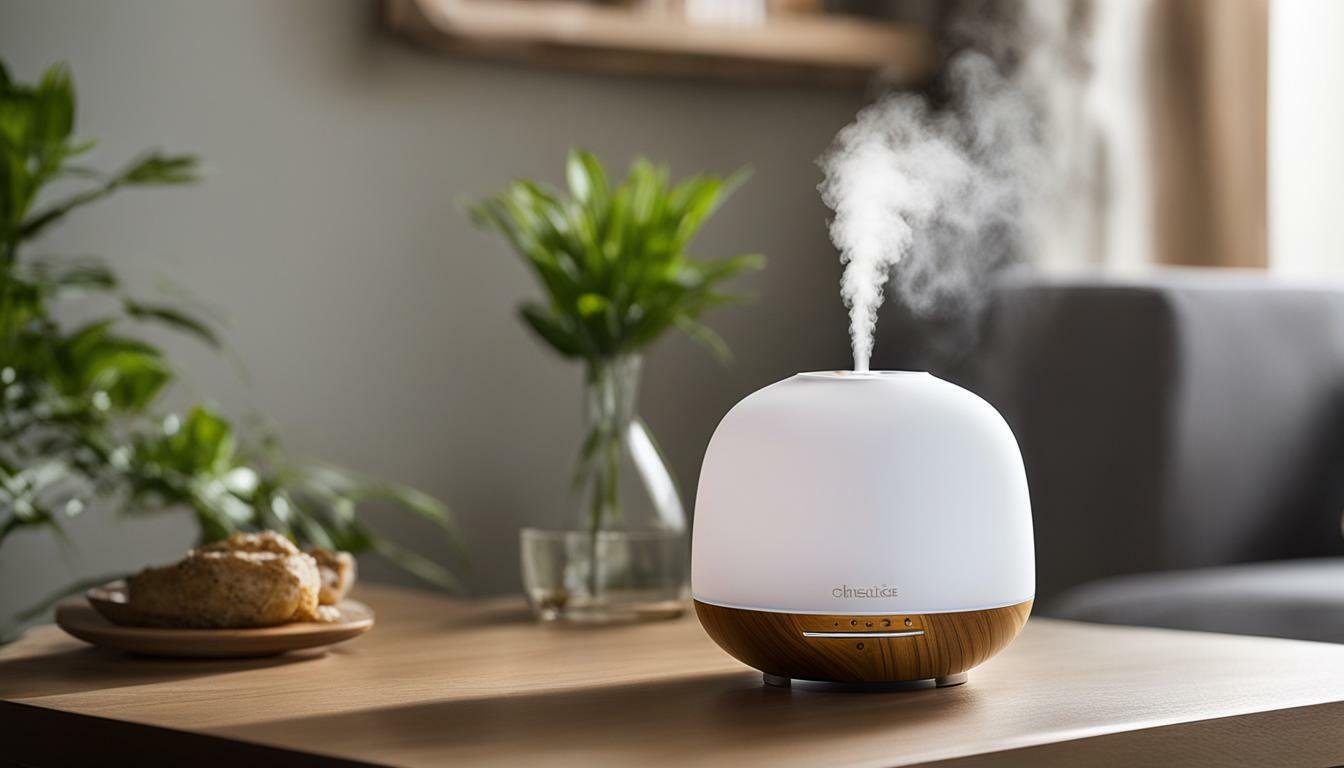
An oil diffuser is a device that utilizes different mechanisms to release essential oils into the air, providing a pleasant and therapeutic experience.
There are four main types of oil diffusers – nebulizing, ultrasonic, evaporative, and heat – each with its own unique way of dispersing essential oils. These devices have gained popularity in US households as a popular wellness tool.
Nebulizing diffusers, for example, use high pressure air to atomize the essential oils, breaking them down into tiny particles that are then released into the environment. This method allows for maximum therapeutic benefits as the oils are not diluted with water.
Ultrasonic diffusers, on the other hand, use ultrasonic vibrations to create a microfine mist of essential oil particles. These diffusers are also popular because they often come with built-in color-changing lights that create a soothing ambiance.
Evaporative diffusers rely on natural evaporation or a fan to distribute the essential oils. When the oils are exposed to air, they naturally evaporate and disperse their aroma throughout the room. Some evaporative diffusers also use a fan to help circulate the fragrance.
Heat diffusers, as the name suggests, use heat to evaporate the essential oils and release their aroma. These diffusers often come in the form of ceramic or terracotta vessels, which are heated up and then work to distribute the fragrance throughout the space.
Depending on the type of diffuser, the specific way to use it may vary. Generally, it involves selecting a suitable location, adding water (if required), adding the essential oils, and turning on the diffuser. It’s important to read the instructions provided with your specific diffuser to ensure proper usage and maintenance.
In conclusion, oil diffusers offer a convenient and effective way to enjoy the benefits of essential oils. Whether you prefer the atomizing power of a nebulizing diffuser, the soothing mist of an ultrasonic diffuser, the natural evaporation of an evaporative diffuser, or the heat-infused fragrance of a heat diffuser, there is a diffuser out there to suit your needs and enhance your wellness routine.
Types of Oil Diffusers
There are several types of oil diffusers available in the market, each operating in a unique manner to release the aromatic and therapeutic properties of essential oils. Understanding the different types can help you choose the right diffuser for your needs.
Nebulizing Diffusers
Nebulizing diffusers work by using high pressure air to break down essential oils into tiny particles, which are then released into the air as a fine mist. These diffusers do not require water or heat, making them ideal for maintaining the purity of the essential oils. They are also known for their strong and immediate scent dispersion, making them a popular choice for larger rooms or therapeutic settings.
Ultrasonic Diffusers
Ultrasonic diffusers utilize ultrasonic vibrations to create microfine essential oil particles. These particles are then dispersed into the air as a cool mist. Ultrasonic diffusers typically require water as a base and are known for their ability to humidify the air while diffusing the essential oils. They are often used for creating a calming and relaxing atmosphere, as well as for adding moisture to dry environments.
Evaporative and Heat Diffusers
Evaporative diffusers rely on natural evaporation or a fan to disperse the essential oils into the air. These diffusers typically use a pad or a filter to hold the essential oils, which are then evaporated by airflow or heat. Heat diffusers, on the other hand, use heat to evaporate the oils and release their aroma. Both types of diffusers are simple to use and do not require water, making them convenient options for smaller spaces or on-the-go use.
It’s important to note that the specific way to use a diffuser may vary depending on the type of diffuser. However, the general process involves selecting a location, adding water (if required), adding the essential oils, and turning on the diffuser. Experimenting with different types of diffusers can help you find the one that suits your preferences and enhances your well-being.
| Type of Diffuser | Pros | Cons |
|---|---|---|
| Nebulizing | – Strong scent dispersion – Preserves the integrity of essential oils |
– Higher price range – Louder operation |
| Ultrasonic | – Humidifies the air – Quiet operation |
– Requires water as a base – Can be prone to clogging |
| Evaporative | – Simple to use – Portable |
– Scent may not last as long – Limited coverage area |
| Heat | – Easy to use – No water required |
– May alter the chemical composition of oils – Risk of burns if not handled carefully |
How Nebulizing Diffusers Work
Nebulizing diffusers utilize high pressure air to break down essential oils into tiny particles, dispersing them into the air for easy inhalation and maximum therapeutic benefits. These diffusers are known for their ability to preserve the integrity of the essential oils, as they do not require heat or water to operate.
When the nebulizing diffuser is switched on, it pumps air through a small tube into a glass nebulizer. Inside the nebulizer, the air passes over a specially designed glass chamber that contains the essential oils. As the air flows through the chamber, it creates a vacuum that pulls the oils up, atomizing them into a fine mist.
The mist is then released into the environment, where it can be inhaled and absorbed by the body. The small particle size of the mist allows for easy and deep penetration into the lungs and bloodstream, maximizing the therapeutic effects of the essential oils.
| Advantages of Nebulizing Diffusers | Disadvantages of Nebulizing Diffusers |
|---|---|
|
|
Summary
Nebulizing diffusers use high pressure air to break down essential oils into tiny particles, allowing for easy inhalation and maximum therapeutic benefits. They offer a powerful and efficient diffusion method without the need for heat or water. However, they may be louder and consume more oil compared to other diffuser types. Overall, nebulizing diffusers are a popular choice for those seeking a potent and direct way to enjoy the benefits of essential oils.
How Ultrasonic Diffusers Work
Ultrasonic diffusers use advanced technology by vibrating at ultrasonic frequencies, generating a delicate mist of essential oil particles that can spread throughout a room. These diffusers have become increasingly popular due to their ability to disperse the oils effectively while maintaining their therapeutic properties.
The process starts by filling the diffuser’s reservoir with water, typically up to the designated fill line. Next, a few drops of your desired essential oil are added, and the diffuser is turned on. The device uses electronic frequencies to create ultrasonic vibrations that break down the water and oil mixture into tiny droplets.
These tiny droplets are then released into the air as a fine mist, filling the room with your chosen scent. The diffuser also acts as a humidifier, as the water vapor provides moisture to the surrounding environment, making it ideal for dry climates or winter months when the air tends to be drier.
| Advantages of Ultrasonic Diffusers | Disadvantages of Ultrasonic Diffusers |
|---|---|
| They are quiet, making them suitable for use in the bedroom or office. | The mist produced by ultrasonic diffusers can be lighter and may dissipate faster compared to other types of diffusers. |
| They provide continuous diffusion, allowing you to enjoy the aroma of your chosen oils for extended periods. | Some ultrasonic diffusers may require frequent cleaning to prevent mineral buildup from tap water. |
| Most ultrasonic diffusers are easy to use and operate. | They tend to have smaller water reservoirs, requiring more frequent refills. |
| They are often aesthetically pleasing and can serve as decorative pieces in any room. | Ultrasonic diffusers may be relatively more expensive compared to other types of diffusers. |
Overall, ultrasonic diffusers offer a convenient and effective way to enjoy the benefits of essential oils. Their gentle mist, combined with the therapeutic properties of the oils, can create a relaxing and rejuvenating atmosphere in any space.
How Evaporative and Heat Diffusers Work
Evaporative diffusers harness the power of natural evaporation or utilize a fan to circulate air, allowing essential oils to evaporate and diffuse their fragrance. These diffusers typically consist of a reservoir or pad where the essential oils are placed. As air passes over the oils, they naturally evaporate, dispersing their therapeutic aromas throughout the room. Some models may also incorporate a fan to enhance the evaporation process, ensuring a more effective diffusion.
Heat diffusers, on the other hand, employ heat to release the aroma and therapeutic properties of essential oils. These diffusers typically use a heat source, such as a candle or electric heating element, to gently warm the essential oils. The heat causes the oils to evaporate and disperse into the air, filling the space with their pleasant fragrance. Heat diffusers are often used for their ability to create a cozy ambiance while diffusing the oils, making them a popular choice for relaxation and stress relief.
Pros and Cons
| Evaporative Diffusers | Heat Diffusers |
|---|---|
|
|
|
|
Both evaporative and heat diffusers offer unique advantages and can be suitable for different preferences and needs. Whether you opt for an evaporative diffuser for its simplicity and portability or choose a heat diffuser to create an inviting ambiance, these types of diffusers provide a convenient way to enjoy the benefits of essential oils in your space.
Conclusion
Oil diffusers are highly versatile devices that come in various types, each offering its unique method of dispersing essential oils into the air, making them an essential addition to any US household seeking aromatic and therapeutic benefits.
Nebulizing diffusers use high pressure air to atomize the essential oils, releasing them into the environment in their purest form. This method preserves the oil’s natural properties and fragrance, providing a potent and concentrated aroma.
On the other hand, ultrasonic diffusers utilize ultrasonic vibrations to create microfine particles of essential oils that are dispersed as a fine mist. This gentle mist not only fills the room with fragrance but also adds moisture to the air, promoting a soothing and relaxing atmosphere.
Evaporative and heat diffusers work differently, relying on natural evaporation or heat to distribute the essential oils. Evaporative diffusers use a fan to blow air over a pad or filter containing the oils, gradually releasing their aroma into the surrounding space. Heat diffusers, on the other hand, use heat to evaporate the oils and disperse their fragrance.
In general, using an oil diffuser involves selecting a suitable location, adding water (if required), adding the desired essential oils, and turning on the diffuser. With their ability to create a therapeutic ambiance and provide numerous health benefits, oil diffusers have become a popular wellness tool in homes across the United States.
FAQ
How does an oil diffuser work?
An oil diffuser is a device that disperses essential oils into the air using air pressure, mist, a fan, or a heat source. The specific way to use a diffuser depends on the type of diffuser, but generally involves selecting a location, adding water (optional), adding the essential oils, and turning on the diffuser.
What are the types of oil diffusers?
There are four main types of oil diffusers – nebulizing, ultrasonic, evaporative, and heat. Each type operates differently to disperse essential oils into the air for various therapeutic purposes.
How do nebulizing diffusers work?
Nebulizing diffusers use high pressure air to atomize the essential oils and release them into the environment. This ensures that the oils are dispersed in their purest form without dilution or alteration.
How do ultrasonic diffusers work?
Ultrasonic diffusers use ultrasonic vibrations to create microfine essential oil particles that are dispersed as mist. This method of diffusion is gentle and does not alter the chemical composition of the oils.
How do evaporative and heat diffusers work?
Evaporative diffusers use natural evaporation or a fan to distribute the essential oils. Heat diffusers, on the other hand, use heat to evaporate the oils and release their aroma. Both methods are effective in diffusing the oils but may vary in terms of intensity and speed of diffusion.

